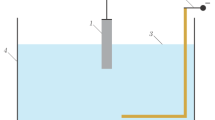Abstract
The results of a study of aluminum welding by reverse-polarity direct current in a medium of protective gases (argon) at the stage of the binding and formation of the pool of melted metal are presented. It is shown that cathode spots in a current range of 5–50 A and action time of up to 1 s do not clean the cathode film from the aluminum surface but remelt the surface layer. The types of cathode spots that form on the aluminum surface are analyzed. It is shown that evaporation is the main mechanism for the removal of the oxide film. A new mechanism of the interaction between a welding arc discharge an aluminum surface is proposed: the main role in the formation of the welding pool is played by an immobile cathode spot, which, on the one hand, evaporates the oxide film and, on the other, intensely heats the surface layer of the aluminum to the phase transition due to high heat density. After the formation of the welding pool, the immobile cathode spot disappears, followed by the diffusion regime of welding arc burning. The regime is characterized by a uniform distribution of the electric field over the length of the discharge gap with a low potential decrease and occupies almost whole interelectrode gap.









Similar content being viewed by others
Notes
Additional materials are situated at DOI https://doi.org/10.1134/S0018151X19060063
REFERENCES
Balanovskii, A.E., High Temp., 2018, vol. 56, no. 3, p. 319.
Balanovskii, A.E., High Temp., 2018, vol. 56, no. 4, p. 486.
Nikiforov, G.D., Metallurgiya svarki plavleniem alyuminievykh splavov (Metallurgical Aspects of Fusion Welding of Aluminum Alloys), Moscow: Mashinostroenie, 1972.
Mathers, G., The Welding of Aluminium and Its Alloys, Cambridge: Woodhead, 2002.
Sarrafi, R. and Kovacevic, R., Weld. J., 2010, vol. 89, p. 1.
Abralov, M.A., Argonodugovaya svarka alyuminievykh splavov (Argon Arc Welding of Aluminum Alloys), Tashkent: Fan, 1989.
Yusufova, Z.A. and Leskov, G.I., Svar. Proizvod., 1970, no. 7, p. 57.
Budnik, V.P., Rabkin, D.M., Smiyan, O.D., and Tovmachenko, V.N., Avtom. Svarka, 1975, no. 10, p. 74.
Budnik, V.P, Avtom. Svarka, 1994, no. 12, p. 23.
Sarrafi, R. and Kovacevic, R., Proc. Inst. Mech. Eng.,Part B, 2009, vol. 223, p. 1143.
Shi, Z., Yuan, Q., Zhao, R., et al., IEEE Trans. Plasma Sci., 2011, vol. 39, no. 7, p. 1585.
Takeda K. and Takeuchi, S., Mater. Trans.,JIM, 1997, vol. 38, no. 7, p. 636.
Saito, M., Tobe, S., Iwao, T., and Inaba, T., in Proc. 22nd Int. Symp. on Discharges and Electrical Insulation in Vacuum (ISDEIV), Matsue, 2006, p. 550.
Shi, Z., Li, W., Yan, N., Zhang, Y., et al., in Proc. 25th Int. Symp. on Discharges and Electrical Insulation in Vacuum (ISDEIV), Tomsk, 2012, p. 293.
Tang, Z., Wu, R., Yang, S., et al., IEEE Trans. Plasma Sci., 2015, vol. 43, no. 5, p. 1793.
Tang, Z.L., Yang, K., Liu, H.X., et al., Phys. Plasmas, 2016, vol. 23, no. 3, 033501.
Takeda, K. and Sugimoto, M., IEEE Trans. Plasma Sci., 2001, vol. 29, no. 5, p. 718.
Li, W., Shi, Z., Wang, C., et al., IEEE Trans. Plasma Sci., 2017, vol. 45, no. 1, p. 106.
Kamishima, S., Iwao, T., and Yumoto, M., IEEJ Trans. Electr. Electron. Eng., 2010, vol. 5, no. 6, p. 670.
Sato, A., Iwao, T., and Yumoto, M., IEEE Trans. Plasma Sci., 2007, vol. 35, no. 4, p. 1004.
Takeda, K., Surf. Coat. Technol., 2000, vol. 131, nos. 1–3, p. 234.
Shi, Z., Jia, S., Wang, L., Yuan, Q., and Song, X., J. Phys. D: Appl. Phys., 2008, vol. 41, no. 17, 175209.
Mesyats, G.A., Ektony v vakuumnom razryade: proboi, iskra, duga (Actons in a Vacuum Discharge: Breakdown, Spark, Arc), Moscow: Nauka, 2000.
Iwao, T., Inagaki, Y., and Yumoto, M., Vacuum, 2006, vol. 80, nos. 11–12, p. 1284.
Rakhovskii, V.I., Fizicheskie osnovy kommutatsii elektricheskogo toka v vakuume (Physical Principles of Switching Electric Current in Vacuum), Moscow: Nauka, 1970.
Vacuum Arcs: Theory and Application, Lafferty, J.M., Ed., New York: Wiley, 1980.
Lyubimov, G.A. and Rakhovskii, V.I., Sov. Phys. Usp., 1978, vol. 21, no. 4, p. 693.
Tashiro, S., Sawato, H., and Tanaka, M., Trans.JWRI, 2010, vol. 39, no. 2, p. 180.
Lenivkin, V.A., Dyurgerov, N.G., and Sagirov, Kh.N., Tekhnologicheskie svoistva svarochnoi dugi v zashchitnykh gazakh (Technological Properties of a Welding Arc in Shielding Gases), Moscow: Mashinostroenie, 1989.
Lapin, I.E., Kosovich, V.A., and Savinov, A.V., Svar. Proizvod., 1996, no. 10, p. 17.
Zhao, L., Wang, Q., Yingchun, G., Cong, B., Surf. Rev. Lett., 2015, vol. 22, no. 6, 1 550 079.
Balanovskii, A.E., Svar. Proizvod., 2016, no. 6, p. 31.
Balanovskii, A.E., High Temp., 2016, vol. 54, no. 5, p. 627.
Ros, J. and Anders, A., J. Phys. D: Appl. Phys., 2008, vol. 38, no. 23p. 4184.
Wang, Q., Yingchun, G., Cong, B., and Qi, B., J. Laser Appl., 2016, vol. 28, 022507.
Dimogerontakis, T., Oltra, R., and Heintz, O., Appl. Phys. A, 2005, vol. 81, no. 6, p. 1173.
Li Meng, Xie De-Gang, Ma Evan, Li Ju, Zhang Xi-Xiang, and Shan, Z.-W., Nat. Communю, 2017, vol. 8, p. 14564.
Xie, D.-G., Wang, Z.-J., Sun, J., Li, J., Ma, E., and Shan, Z.-W., Nat. Mater., 2015, vol. 14, p. 1038.
Katoh, M., Nishio, K., Yamaguchi, T., and Mukae, S., Weld. Int., 1995, vol. 9, no. 5, p. 360.
Author information
Authors and Affiliations
Corresponding author
Additional information
Translated by A. Nikol’skii
Supplementary material
Rights and permissions
About this article
Cite this article
Balanovskii, A.E. A New Mechanism of Interaction between a Welding Arc Discharge of Reverse-Polarity Direct Current and an Aluminum Surface. High Temp 57, 784–797 (2019). https://doi.org/10.1134/S0018151X19060063
Received:
Revised:
Accepted:
Published:
Issue Date:
DOI: https://doi.org/10.1134/S0018151X19060063



